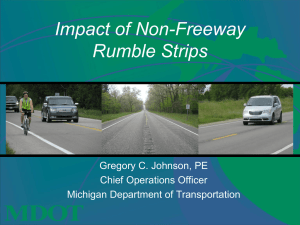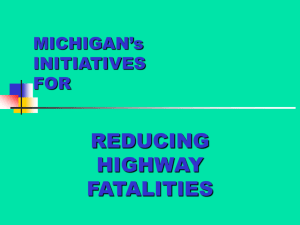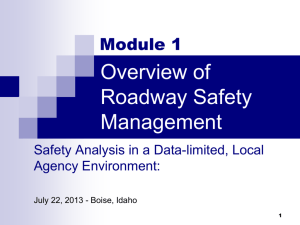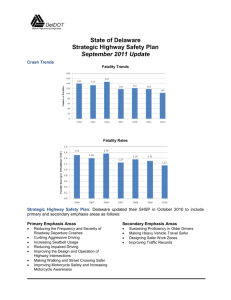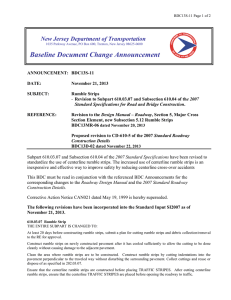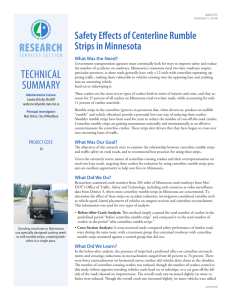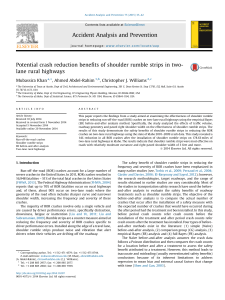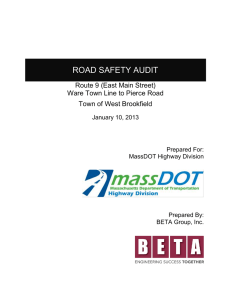Louisiana Local Road Safety Program Presented by
advertisement
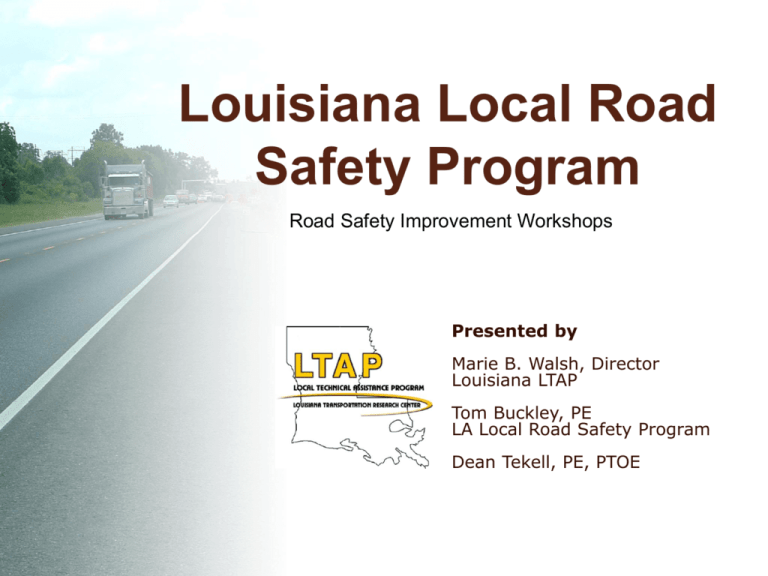
Louisiana Local Road Safety Program Road Safety Improvement Workshops Presented by Marie B. Walsh, Director Louisiana LTAP Tom Buckley, PE LA Local Road Safety Program Dean Tekell, PE, PTOE The Road Safety Problem in LA National Rankings: ◦ 5th highest fatality rate Source: Cost estimates are based on a study conducted by NHTSA in 2000, “The Economic Impact of Motor Vehicle Crashes.” Opportunity state in 2008 and focus state in intersection crashes and roadway departures 965 fatalities in 2005 158,452 crashes in 2005 $5.97 billion in total costs $2,103 for every licensed driver Crash Clock A fatality on average every 9 hours A crash every 3 ½ minutes The Problem at the Local Level 62,169 crashes in 2005 ◦ 39% of the state’s total 205 fatalities in 2005 ◦ 21% of the state’s total Kinds of Crashes Intersection crashes – 30,245 Roadway departures – 3,306 Head on collisions – 912 Using the 4 E’s Engineering ◦ Improved Design and Safety Enhancements: rumble strips, signs and pavement markings, clear zones Education ◦ Public awareness and training Enforcement ◦ Working with law enforcement as a partner to identify and solve problems Emergency services Leveraging the Golden Hour Local Road Safety Program Designed to reduce crashes & fatalities on Louisiana’s local road system ◦ Increase community awareness ◦ Utilize data ◦ Provide funding for prioritized funds LRSP Services Getting Community Initiatives Started Training and Education Technical Assistance Data Evaluation Road Safety Reviews Safety improvement alternatives Road Safety Improvement Project funds Other Resources Local Road Safety Improvement Projects A reimbursement program intended to reduce injuries and fatalities on local roads Maximum project funding of $500,000 with either a 5% or 10% local match Application due October 1 Application available at www.ltrc.lsu.edu/ltap Session I Identifying Problems and Priorities Ask These Questions What is happening in your community? What are the major road safety issues? How do you know this? How can you prove this & make it a priority Obtain and Evaluate Existing Information Gather reports & complaints from the community & other agencies ◦ Public works ◦ Law enforcement ◦ Emergency responders ◦ Fire departments ◦ School system ◦ Business community Obtain Historical Crash Data Contact local law enforcement Contact LTAP Use actual crash data to construct a road safety profile for your community Conduct a RSA on a prioritized location based on data or reports Road Safety Profile Example Road Safety Profile Example – Local Roads Session II What Can Your Data Tell You? Information in the Crash Database Crash and fatality locations Manner of collision Roadway characteristics Severity of crashes Graphical overview of the roads with the most crashes in your area Intersection Crash Reports Crash number, date, & time Alignment Primary contributing factor Secondary contributing factor Primary road Intersecting road Location type Manner of collision Number of injuries Non-Intersection Crash Reports Crash number, date, & time Alignment Location type Manner of collision Total injuries Road name Distance and direction Road relation Example Limitations of the Data No absolute locations without GPS Location data limited to intersections and the roadway for non-intersection crashes Not all local law enforcement agencies submit their data to LA DOTD Accuracy only to the crash report itself Session III Low-Cost Safety Improvements Horizontal Curve Safety Material Presented from Low Cost Treatments for Horizontal Curve Safety, FHWA publication number FHWA-SA-07-002 Basic Treatments Signing: ◦ Centerline ◦ Edgeline ◦ Horizontal alignment signs ◦ Curve speed signs ◦ Advisory speed plaque ◦ Chevron alignment ◦ Delineators Enhanced Basic Treatments Getting the motorist’s attention: ◦ Flashing beacons ◦ High retroreflective intensity & fluorescent yellow sheeting on signs ◦ Thermoplastic markings ◦ Raised pavement markers Rumble Strips Formed in the pavement surface by grooves or placement of strips of material above the surface Use Roadway Rumble Strip (RRS) to alert the approaching curve Minor Roadway Improvements Paved shoulder treatment ◦ Replacement of unstable or narrow shoulders with paved shoulders Shoulder drop-off elimination Widen shoulder Skid-resistive pavement surface treatment Speed Displays Dynamic message signs that use radar to measure speeds of approaching vehicles Between $5,500 - $20,000 for trailers Can be used to enforce school zone speed limits Cable Barriers Can be used on the roadside to prevent run-off-road (RoR) or in medians to prevent crossover crashes Flexible system that dissipates impact energy by deflection Larger, clear areas are needed to be effective Rumble Strips Centerline rumble strips (CLRS) to alert driver to crossing into the opposing lane Shoulder (edgeline) rumble strips (SRS) to prevent roadway departures Session IV Key Application Points Page 1 Project title Location information Applicant & sponsor contact information Page 2 Project description Identify the problem that is occurring and why Describe your proposed countermeasure in thorough detail Page 3 Attach supporting data List of attempted countermeasures Page 4 Defining the limits of the project Roadway description ◦ Lanes ◦ Sketch of modification ◦ Types of traffic Page 5 Roadway description continued Nearby property identified Right-of-way acquisition or drainage issues Page 6 How the project will reduce crashes Sponsor maintenance Itemizing Costs List of individual costs related to the project Sources of match Signature of the applicant Types of Projects Data management systems ◦ Sign inventory system ◦ Crash analysis software Roadway Improvements ◦ ◦ ◦ ◦ ◦ Line-of-sight improvements Turn lanes Sidewalks Roadside hazard removal Rumble strips Signs and pavement markings 2006 Eligible Examples Variable message boards Sign management systems Guardrail installation Roundabout at hazardous intersection Signing for parishes Striping 2006 Ineligible Projects 6 Projects on State Roads ◦ 1 sub-division security/beautification ◦ 2 dust control and embankment improvement projects deemed maintenance issues and not eligible for funding under this program. ◦ 1 school zone ◦ 3 sidewalk construction What Makes a Successful Project? Usage of data and statistics to back up the need for the improvement High impact, low cost Ability to evaluate, maintain and follow up Part of an overall community effort to implement local road safety More Tips for a Successful Project Involvement of Law Enforcement to identify or confirm high priority issues Involvement of other stakeholders Consideration of the 4 E’s
